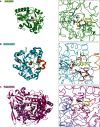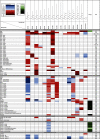Engineering acyl-homoserine lactone-interfering enzymes toward bacterial control
- PMID: 32690609
- PMCID: PMC7489903
- DOI: 10.1074/jbc.REV120.013531
Engineering acyl-homoserine lactone-interfering enzymes toward bacterial control
Abstract
Enzymes able to degrade or modify acyl-homoserine lactones (AHLs) have drawn considerable interest for their ability to interfere with the bacterial communication process referred to as quorum sensing. Many proteobacteria use AHL to coordinate virulence and biofilm formation in a cell density-dependent manner; thus, AHL-interfering enzymes constitute new promising antimicrobial candidates. Among these, lactonases and acylases have been particularly studied. These enzymes have been isolated from various bacterial, archaeal, or eukaryotic organisms and have been evaluated for their ability to control several pathogens. Engineering studies on these enzymes were carried out and successfully modulated their capacity to interact with specific AHL, increase their catalytic activity and stability, or enhance their biotechnological potential. In this review, special attention is paid to the screening, engineering, and applications of AHL-modifying enzymes. Prospects and future opportunities are also discussed with a view to developing potent candidates for bacterial control.
Keywords: acyl-homoserine lactones quorum sensing; acylase; antibiotic resistance; biofilm; enzyme catalysis; lactonase; protein engineering; quorum quenching; virulence factor.
© 2020 Billot et al.
Conflict of interest statement
Conflict of interest—M. E. and E. C. have a patent, WO2014167140 A1, licensed to Gene&GreenTK; R. B., L. P., P. J., D. D., and E. C. report personal fees from Gene&GreenTK.
Figures





References
Publication types
MeSH terms
Substances
Associated data
- Actions
- Actions
- Actions
Grants and funding
LinkOut - more resources
Full Text Sources
Other Literature Sources
Medical

